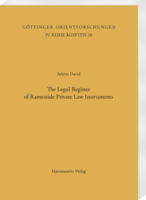|
|
Download:
Please note: With adding digital Products to your cart
the payment will be handled via PayPal. The download will be provided after the payment is confirmed. Pursuing the study of legal discourse in ancient Egypt during the well documented 19th and 20th dynasties (circa 1300–1100 B.C.), the book describes the legal language used in recording wills and gifts. It is compared with the language of royal decrees tackled by the author’s Syntactic and Lexico- Semantic Aspects of the Legal Register in Ramesside Royal Decrees (previously published in the same collection), and with some examples of legal languages associated with private instruments in Antiquity, the Middle Ages, and in modern times. After presentation of the criteria used to establish the corpus and the multiple dilemmas involved, each text is analyzed for its linguistic and graphic features, as well as the lexico-semantic features associated with the categorization system embedded in the script (for terminology of spezial legal relevance). Related textual categories such as partitions, ‘social gifts’, and contract-related records are dealt with separately as they did not constitute enforceable private law instruments. A distinct Ramesside private deeds register (variety of language distinguished according to use) emerges from the analysis, resulting from choices and strategies adapted to a specific legal topic and communicative purpose.
|
|||||||||||||||||||||||||||||||||||||||||






